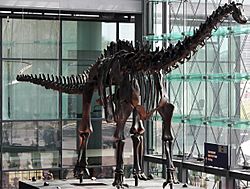Diplodocid facts for kids
Quick facts for kids Diplodocids |
|
|---|---|
 |
|
| Diplodocus carnegii skeleton cast, Berlin Hauptbahnhof | |
| Scientific classification |
|
| Kingdom: | Animalia |
| Phylum: | Chordata |
| Clade: | Dinosauria |
| Clade: | Saurischia |
| Suborder: | †Sauropodomorpha |
| Clade: | †Sauropoda |
| Clade: | †Flagellicaudata |
| Family: | †Diplodocidae Marsh, 1884 |
| Type species | |
| †Diplodocus longus Marsh, 1878
|
|
| Subgroups | |
|
|
| Synonyms | |
|
|
Diplodocids are a group of very long-necked, plant-eating dinosaurs. They are famous for being some of the longest animals to ever live on Earth. These amazing creatures walked the planet during the Middle Jurassic to Early Cretaceous periods. This means they lived about 170 to 136 million years ago! Famous diplodocids include Diplodocus and Supersaurus.
Contents
Diplodocids: Giant Long-Necked Dinosaurs
Diplodocids belong to a larger group of dinosaurs called sauropods. Sauropods are known for their incredibly long necks and tails, and their huge bodies. The family name "Diplodocidae" means "double beams." This refers to special bones found in their tails. These bones helped support their long, heavy tails.
Some diplodocids, like Supersaurus, could grow up to 34 meters (about 112 feet) long! That's longer than three school buses lined up end-to-end. They were truly gigantic creatures.
How Did Diplodocids Eat?
Diplodocids were herbivores, meaning they only ate plants. They had unique, peg-like teeth. These teeth were perfect for stripping leaves from branches. They didn't chew their food much. Instead, they swallowed leaves whole.
To help digest their food, diplodocids swallowed gastroliths. These were small stones that stayed in their stomachs. The stones helped grind up the tough plant material. Tiny bacteria in their large stomachs also helped break down the plant fibers. This process allowed the dinosaurs to get all the nutrients from the leaves.
Types of Diplodocids
The diplodocid family is divided into two main groups, or sub-families:
- Diplodocinae: This group includes Diplodocus and other dinosaurs that were generally long and slender. They had very long necks and tails.
- Apatosaurinae: This group includes Apatosaurus and other types that were typically more stocky and heavily built. Brontosaurus is also part of this group.
Diplodocid Family Tree
Diplodocids had cousins like the brachiosaurs. Brachiosaurs were another group of large sauropods. They are put into a separate, but related, family. Much later, the titanosaurs appeared. Titanosaurs were the last major group of sauropods on Earth before the dinosaurs went extinct.
Images for kids
-
Diplodocus, depicted with spines limited to the mid-line of the back
-
Holotype specimens of Diplodocus carnegii and Apatosaurus louisae at Carnegie Museum of Natural History
See also
 In Spanish: Diplodócidos para niños
In Spanish: Diplodócidos para niños






